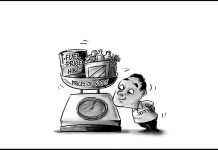
“LIGHTS will guide you home.” So goes the song of Coldplay. As seen from the photographs and videos shared by those who attended the band’s Music of the Spheres World Tour in Bulacan on Friday, lights were all over the Philippine Arena and what a sight it was.
Electrifying shows usually come to life because of lighting, huge screens, confetti, balloons, even outfits. In the case of Coldplay, they also provide wristbands to their audience. Called xylobands, these wristbands were first used in October 2011 when Coldplay performed in Madrid — a show dubbed as Unstaged and which was broadcasted live in some countries — and then made their way to the Mylo Xyloto Tour and the Charlie Brown official music video. “We’ll be glowing in the dark.” Those flashing wristbands, pulsating to the beat of the song, were spectacular.
Coldplay prides itself with not just creating a memorable concert experience for their fans but also lessening their shows’ environmental impact. The wristbands are collected at the end of each show so they can be sterilized and recharged and used for future shows. According to their website (www.sustainability.coldplay.com), such efforts have reduced production of wristbands by 80% and during the first year of the Music of the Spheres World Tour the return rate from the audience has averaged 86%. Husay.
If that was the average, how did we do? A Wristband Recycling Leaderboard compiled the return rate for specific countries, with Tokyo at 97%, Buenos Aires at 94%, Amsterdam at 87%, Vancouver at 82%, and Los Angeles at 80%. Ours was 87%.
It shouldn’t surprise anyone that the Japanese showed the highest return rate. Whatever the situation, they have shown tremendous discipline — the most recent example happened in Tokyo where all 379 passengers and crew of a Japan Airlines evacuating from a burning plane. They are huge music fans too. They have been described by the CEO of Sony Music Entertainment (Japan) as having “a collector’s mindset, making them partial to the physical product.” A Coldplay wristband would have made a nice collection and yet 9 out of 10 Japanese still returned it as the band had requested.
Given the average return rate, we, Filipinos, ranked in the middle. At least, not last. But such result has touched a nerve among Pinoys. Come to think of it, if the Philippine Arena has a 55,000 capacity, it means that 7,150 individuals ignored the band’s campaign to recycle the traveling wristbands. Maybe the temptation to keep memorabilia was just too much. “Nobody said it was easy.” For sure it’s not always easy to care about the environment. It’s not so simple, following instructions. It can feel so much better to focus on your needs, not just as a fan but as someone who has spent thousands to go to that show.
Whatever the explanation, and despite the disappointment felt by many, this could be a learning experience for us. If more than 40,000 people in the Philippine Arena chose to turn over the wristbands, that has to mean something. Incidentally, someone who went to the concert shared with me that the crowd was patient while waiting in line and the atmosphere was all good vibes. What made them that way for that particular night? “Everything’s not lost,” is what I’m saying. There must be a way of cultivating a culture that listens and listens well, that acts more conscientiously, that understands pursuits that go beyond the self. There must be a way of persuading our families, our neighbors, our friends, our students, our elders, to do just that./PN







